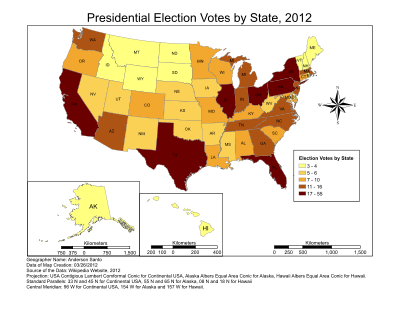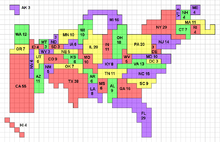Electoral college
| Part of the Politics series | ||||
| Elections | ||||
|---|---|---|---|---|
| Basic types | ||||
| Terminology | ||||
|
|
||||
| Subseries | ||||
| Lists | ||||
|
||||
| Related | ||||
| Politics portal | ||||

An electoral college is a set of electors who are selected to elect a candidate to a particular office. Often these represent different organizations, political parties, or entities, with each organization, political party or entity represented by a particular number of electors or with votes weighted in a particular way. Many times, though, the electors are simply important people whose wisdom would ideally provide a better choice than a larger body. The system can ignore the wishes of a general membership.
Origins of electoral colleges
Early Germanic law stated that the German king led only with the support of his nobles. Thus, Pelayo needed to be elected by his Visigothic nobles before becoming king of Asturias, and so did Pepin the Short by Frankish nobles in order to become the first Carolingian king. While most other Germanic nations had developed a strictly hereditary system by the end of the first millennium, the Holy Roman Empire did not, and the King of the Romans, who would become Holy Roman Emperor or at least Emperor-elect, was selected by the college of prince-electors from the late Middle Ages until 1806 (the last election took place in 1792).
In the Church, both the clergy and laity elected the bishop or presiding presbyter. However, for various reasons, such as a desire to reduce the influence of the state or the laity in ecclesiastical matters, electoral power became restricted to the clergy and, in the case of the Church in the West, exclusively to a college of the canons of the cathedral church. In the Pope's case, the system of people and clergy was eventually replaced by a college of the important clergy of Rome, which eventually became known as the College of Cardinals. Since 1059, it has had exclusive authority over papal selection.
In the 19th century and beyond, it was usual in many countries that voters did not directly vote the members of parliament. In Prussia for example, in 1849–1918 the voters were Urwähler (original voters), appointing with their vote a Wahlmann (elector). The group of electors in a district elected the deputy for the Prussian House of Representatives. Such indirect suffrage was a means to steer the voting, to make sure that the electors were "able" persons. For electors, the requirements were usually higher than for the original voters. The left wing opposition was very much opposed to indirect suffrage.
Even today in the Netherlands, the deputies of the First Chamber are elected by the provincial parliaments. Those provincial parliaments form the electoral colleges for the First Chamber elections; the lists of candidates are national.
Modern electoral colleges

Countries with complex regional electorates may elect a head of state by means of an electoral college rather than a direct popular election. The United States Electoral College is an example of a system in which an executive president is indirectly elected,[1] with electors representing the 50 states and the federal district. Each state has a number of electors equal to its Congressional representation (in both houses), with the non-state District of Columbia receiving three electors and other non-state territories having no electors.[2] The electors generally cast their votes for the winner of the popular vote in their respective states.[3] However, there are several states where this is not required by law. In the United States, 270 electoral votes are currently required to win the presidential election.[4]
Similar systems are used in other presidential elections around the world. In Germany, the members of the federal parliament together with an equal number of people elected from the state parliaments constitute the Federal Convention, that exists for the only purpose of electing the (non-executive) head of state.[5] Similarly, in India the members of the both houses of parliament together with weighted votes from the members of the state legislative assemblies constitute an electoral college that elects the head of state.[6] In Italy the presidential electoral college is composed of the members of both houses of Parliament and three members elected by each of the regional assemblies.
Other countries with electoral college systems include Burundi, Estonia,[7] Kazakhstan, Madagascar, Myanmar, Pakistan, Trinidad and Tobago[8] and Vanuatu. Both the French Senate and the Seanad Éireann (Senate) in Ireland are chosen by electoral colleges. Within China, both Macau[9] and Hong Kong each have an Election Committee which functions as an electoral college for selecting the Chief Executive and formerly (in the case of Hong Kong) for selecting some of the seats of the Legislative Council.
Ecclesiastical electoral colleges abound in modern times, especially among Protestant and Eastern Rite Catholic Churches. In the Eastern rite churches, all the bishops of an autocephalous church elect successor bishops, thus serving as an electoral college for all the episcopal sees.
Former electoral colleges
Historical examples of electoral colleges include Finland's, which elected the country's president between 1919 and 1987. During Brazil's military rule period, the president was elected by an electoral college comprising senators, deputies, state deputies, and lawmakers in the cities. Argentina had an electoral college established by its original 1853 constitution, which was used to elect its president during that country's periods of democracy.[10] The constitution was reformed in 1994 and the electoral college was replaced with a direct election by popular vote. In France, the first presidential election of the Fifth Republic was the only presidential election where the winner was determined via an electoral college.
Another type of Electoral College was used by the British Labour Party to choose its leader between 1983 and 2010. The college consisted of three sections: the votes of Labour MPs and MEPs; the votes of affiliated trade unions and socialist societies; and the votes of individual members of Constituency Labour Parties.[11]
Early in U.S. history, state legislatures were essentially electoral colleges for both the U.S. Senate and even the federal Electoral College itself. Prior to 1913, U.S. state legislatures appointed U.S. senators from their respective states, and prior to 1872, U.S. presidential electors were in many cases chosen by state legislatures (though most states had switched to popular elections for electors by 1824). Because state legislatures had so much influence over federal elections, state legislative elections were frequently proxy votes for either the Senate or the presidency. The famed 1858 Lincoln–Douglas debates were held during a U.S. Senate campaign between the two rivals in Illinois, which was actually an election for the Illinois state legislature. During the American Civil War, the Confederacy used an Electoral College that was functionally identical to that of the United States; it convened just once, in 1861, to elect Jefferson Davis as president.
References
- ↑ Collin, Richard Oliver; Martin, Pamela L. (2012-01-01). An Introduction to World Politics: Conflict and Consensus on a Small Planet. Rowman & Littlefield. ISBN 9781442218031.
- ↑ "Presidential Election Laws".
- ↑ "Who are the Electors?".
- ↑ "What happens if no presidential candidate gets 270 Electoral votes?".
- ↑ The Federal President and the Federal Convention – retrieved on 16 January 2015
- ↑ Constitution of India 84th Amendment – retrieved on 16 January 2015
- ↑ Constitution of Estonia, section 79 – retrieved on 4 April 2008
- ↑ Constitution of Trinidad and Tobago, section 28 – retrieved on 4 April 2008
- ↑ Austin Ramzy (9 July 2014). "Macau Activists Plan Hong Kong-Style Poll on Greater Democracy". The New York Times.
- ↑ The Constitution of Argentina of 1853, 32nd to 63rd Articles – retrieved on 16 January 2015
- ↑ Labour Party Rule Book rule 4B.2c – quoted in House of Commons Research Note SN/PC/3938: Labour Party Leadership Elections retrieved 6 February 2008
External links
- "A Handbook of Electoral System Design" from International IDEA
- A New Nation Votes: American Election Returns 1787–1825